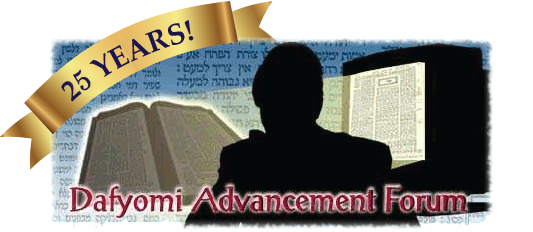Get Study
Material Sponsors
& Donors Member's
site Talmud by
the Daf Talmud by
Maseches Chumash Nevi'im &
Kesuvim Haftarah
Highlights Yerushalmi Mishnah Halachah Mishnah
Berurah Moadim Lectures Orders Dafyomi
Central Kollel Iyun
Hadaf Feedback Ask a
Question
Material Sponsors
& Donors Member's
site Talmud by
the Daf Talmud by
Maseches Chumash Nevi'im &
Kesuvim Haftarah
Highlights Yerushalmi Mishnah Halachah Mishnah
Berurah Moadim Lectures Orders Dafyomi
Central Kollel Iyun
Hadaf Feedback Ask a
Question
-
Kadesh
until Yachatz -
Magid 1
(intros)- Ha Lachma Anya
- Mah Nishtanah
- Avadim Hayinu
- Ma'aseh b'Rabbi Eliezer
- Amar Rabbi Elazar ben Azaryah
- Baruch Ha'Makom... K'Neged Arba'ah Banim
- Chacham, Mah Hu Omer
- Rasha, Mah Hu Omer
- Tam, Mah Hu Omer
- V'She'Eino Yode'a Lish'ol
- Yachol me'Rosh Chodesh
- Mi'Techilah, Ovedei Avodah Zarah
- Baruch Shomer Havtachaso l'Yisrael
- V'Hi she'Amedah la'Avoseinu v'Lanu
-
Magid 2
(verses)- Tzei u'Lemad... arami Oved Avi
- Va'Yeired Mitzrayimah
- Va'Yagar Sham
- Bi'Mesei Me'at
- Va'Yehi Sham l'Goi
- Gadol, Atzum
- Va'Rav
- Va'Yare'u Osanu ha'Mitzrim
- Va'Ye'anunu
- Va'Yitenu Aleinu Avodah Kashah
- Va'Nitz'ak El Hashem Elokei Avoseinu
- Va'Yishma Hashem Es Koleinu
- Va'Yar Es Onyeinu
- V'Es Amaleinu
- V'Es Lachatzeinu
- Va'Yotzi'enu Hashem mi'Mitzrayim
- B'Yad Chazakah
- Uvi'Zero'a Netuyah
- Uv'Mora Gadol
- Uv'Osos
- Uv'Mofesim
-
Magid 3
(Makos)- Davar Acher -Eilu Eser Makos
- Dam
- Tzefarde'a
- Kinim
- Arov
- Dever
- Shechin
- Barad
- Arbeh
- Choshech
- Makas Bechoros
- Rabbi Yehudah
- Rabbi Yosi ha'Gelili
- Rabbi Eliezer
- Rabbi Akiva
- Kamah Ma'alos- Dayeinu
- Al Achas Kamah
- Raban Gamliel.. Pesach, Matzah u'Maror
- Pesach she'Hayu
- Matzah Zo
- Maror Zeh
- B'Chol Dor Va'Dor
- Lefichach
- Halelu Avdei Hashem
- B'Tzeis Yisrael
- Asher Ge'alanu
-
Rachtzah
until Barech -
Hallel
& Nirtzah
רַבִּי יוֹסֵי הַגְּלִילִי אוֹמֵר: מִנַּיִן אַתָּה אוֹמֵר שֶׁלָּקוּ הַמִּצְרִים בְּמִצְרַיִם עֶשֶׂר מַכּוֹת, וְעַל הַיָּם לָקוּ חֲמִשִּׁים מַכּוֹת? בְּמִצְרַיִם מַה הוּא אוֹמֵר? וַיֹּאמְרוּ הַחַרְטֻמִּם אֶל פַּרְעֹה, אֶצְבַּע אֱ-לֹקִים הִוא. וְעַל הַיָּם מָה הוּא אוֹמֵר? וַיַּרְא יִשְׂרָאֵל אֶת הַיָּד הַגְּדֹלָה אֲשֶׁר עָשָׂה ה' בְּמִצְרַיִם, וַיִּירְאוּ הָעָם אֶת ה', וַיַּאֲמִינוּ בַּה' וּבְמשֶׁה עַבְדוֹ. כַּמָה לָקוּ בְאֶצְבַּע? עֶשֶׂר מַכּוֹת. אֱמוֹר מֵעַתָּה: בְּמִצְרַים לָקוּ עֶשֶׂר מַכּוֹת, וְעַל הַיָּם לָקוּ חֲמִשִּׁים מַכּוֹת.
Rabbi Yosi Hagelili says, "From where can you [derive] that the Egyptians were struck with ten plagues in Egypt, and struck with fifty plagues at the Sea? In Egypt, what does it state? 'The magicians said unto Pharaoh: ‘This is the finger of G-d' (Exodus 8:15). And at the Sea, what does it state? 'And Israel saw Hashem's great hand that he used upon the Egyptians, and the people feared Hashem; and they believed in Hashem, and in Moshe, His servant' (Exodus 14:31). How many were they struck with with the finger? Ten plagues. You can say from here that in Egypt, they were struck with ten plagues; and at the Sea, they were struck with fifty plagues."



